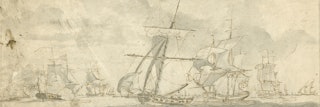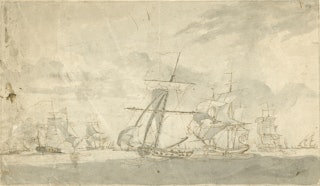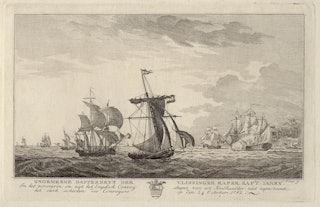As Zeeuwse privateer, Nicolaas Jarry took part in the Fourth English War (1780-1784). The Republic of the United Netherlands, together with France, was battling the powerful English navy.
It was not smooth sailing for the Dutch, as their navy was outnumbered and their mercantile marine suffered as a result. The economical damage was severe. Jarry and other Zeeuwse privateers were cloud’s silver lining, as they brought in ‘trophy’ after ‘trophy’.

The popularity the privateers enjoyed was grand, partly because artists immortalized their acts of valor. In the collections of the Zeeuws Archief one can find a rare portrait of the Zeeuwse privateer captain, as well as an etching with preliminary study of one of his heroic deeds.
The achievements of the Zeeuwse privateers were praised in the ‘Kaperslied’ of the Zeeuwse poet Jacobus Bellamy. Out of all privateer ships, he named the Vlissinger ‘the little boss’ that ‘obtained the best booty’. Subject of this paean was the fast sailing cutter of the French Nicolaas Jarry, which sailed in commission of the Zeeuwse firm Nortier.
One of Jarry’s many valiant deeds is recorded in an etching with the title ‘Extraordinary valor by the Flushinger privateer cap. Jarry in conquering and dragging a ‘koolhaalder’ from the English convoy’. In sight of hostile warships he overpowered an English brig loaded with coal on the 24th of October 1782. He managed to take away the ship and sail it to safety despite being chased by two frigates and two cutters of the English convoy.
Traces of black chalk
The Rotterdamse artist Jan Kobell (1756-1833) captured Jarry’s heroic action in an etching, of which a copy is kept in the collection Zelandia Illustrata of the Koninklijk Zeeuwsch Genootschap der Wetenschappen. This collection, managed by the Zeeuws Archief, includes the preliminary study of the etching, which is a rarity, for often the preparatory drawings were lost. The drawing is more of a sketch in many ways; the artstyle is light and the waves are applied with a small brush.
The back of the drawing still contains traces of the black chalk used by the artist to transfer the picture to the etching plate. The drawing was placed on a copper plate covered in etching ground and carefully engraved. As a result, black lines of chalk remained on the etching ground, after which the artist was able to easily copy the image to a large extent. In the end, he added much more details to the etching than to the drawing, as becomes clear when comparing the two. While drawing on the etching ground, the copper plate becomes exposed. Placed in a bath of acid, the exposed lines are ‘etched’ into the plate. Afterwards the engraved plate is ready to be smeared with ink and printed. Hence, the print is the mirrored image of the original drawing.
Two ‘smertlyke’ days
Many portraits have been sold of the popular Nicolaas Jarry. This would happen after his death. The preliminary drawing was made just before he embarged on what would become his last crusade.
On that unfortunate day in January 1783 he had captured five ships, of which he sent four to safe havens, including their ‘prize crews’. The fifth ship ran aground on the coast. Jarry tried to get the ship afloat again, but was discovered by an English cutter, against which he immediately picked up arms. After an English frigate entered the battle, the Zeeuwse privateer captain realized he did not stand a chance. His ship was understaffed as a result of the dismissed four ‘prize crews’ in addition to being hindered by thirty prisoners of war.
He flew the white as a sign of surrender, but from the cutter a canon with scraps was fired. One piece of scrap buried itself into Jarry’s stomach and ended his life after two ‘smertlyke’ days.
The Zeeuwse artist Jacobus Perkois had made a drawing of Jarry just before his final journey. This particular drawing was used for the etching. The drawing was, according to the Middelburgsche Courant a “rather striking and badly handled drawing, of our captain Jarry, who died on the bed of honor”.

It would not take long before the portrait of Jarry and that of his colleague Le Turc would find its way to the Zeeuwse market in large numbers. Furthermore, it would – according to the Middelburgsche Courant – “offer [the Zeeuwse public] a vivid keepsake to remind them of those, who at the expense of our enemy, dared to fly our colors at sea”. Jarry conquered more than fifty hostile ships.


